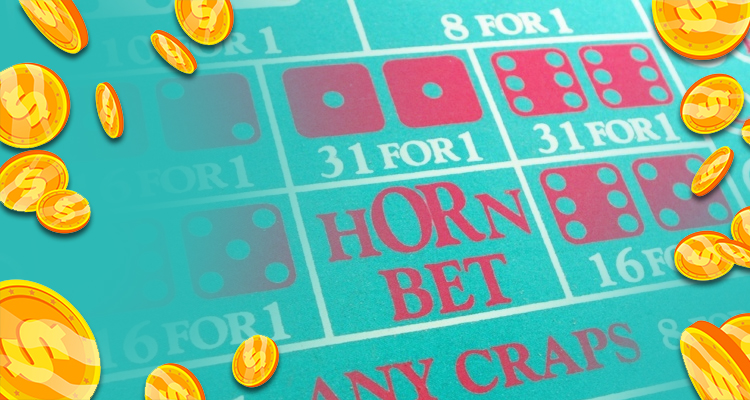Horn Bet Secrets

Larry Edell 09:27 Sep 16th, 2006 Craps
One of the most popular bets on the craps table is "any craps," which is a one-roll bet on the 2, 3 and 12. The theory goes that if you have, say $10 on the pass line, you can lose it all if craps is thrown. But if you bet $2 any craps and if a 2, 3, or 12 rolls, you'll supposedly come out ahead. Since any craps pays 7:1 you will win $14 and lose $10, therefore, you're supposedly ahead by $4. However, the 2 and 12 will roll one time each and the 3 twice (out of 36) so you'll win your any craps bet only 4 times in 36 rolls. So, you'll win $56 ($14 x 4) but have invested $72 (36 x $2) for a net loss of $16.  Some people add an eleven to their bet, the famous "C & E" bet (Craps and Eleven). You are still betting $2 ($1 Craps and $1 Yo). This time, though, in 36 decisions, you've invested $72 ($2 x 36) in hedge bets. The 2 and 12 will have each rolled once, and the three and eleven twice. You would make $7 on the 2 ($1 x 7), $14 on the 3 ($2 x 7), $7 on the 12 ($1 x 7), and $30 on the eleven ($2 x 15). This totals $58 ($7 + $14 + $7 + $30), but you've already invested $72 (36 x $2) so you have a $14 ($72-$58) loss. A horn bet is a one-roll bet on the 2, 3, 11, or 12, and must be bet in multiples of 4. For example, you can make a $4 horn bet or an $8 horn bet, but not a $5 one. Each bet pays off individually. If you bet a $4 horn and the next roll is a 2 or 12, you'll win $30 (at 30:1).
Some people add an eleven to their bet, the famous "C & E" bet (Craps and Eleven). You are still betting $2 ($1 Craps and $1 Yo). This time, though, in 36 decisions, you've invested $72 ($2 x 36) in hedge bets. The 2 and 12 will have each rolled once, and the three and eleven twice. You would make $7 on the 2 ($1 x 7), $14 on the 3 ($2 x 7), $7 on the 12 ($1 x 7), and $30 on the eleven ($2 x 15). This totals $58 ($7 + $14 + $7 + $30), but you've already invested $72 (36 x $2) so you have a $14 ($72-$58) loss. A horn bet is a one-roll bet on the 2, 3, 11, or 12, and must be bet in multiples of 4. For example, you can make a $4 horn bet or an $8 horn bet, but not a $5 one. Each bet pays off individually. If you bet a $4 horn and the next roll is a 2 or 12, you'll win $30 (at 30:1).
If the next roll is a 3 or 11, you'll win $15 (at 15:1). The payoff on a horn bet is significantly higher (either 15:1 or 30:1) than an any craps bet (7:1) even though it has the exact same numbers. By paying an extra $2, you can increase your odds, and many players use a horn bet to protect their pass line instead of a C&E bet. For example, if you have $4 on the horn during the come out and a horn number hits, you'll win $30 for the 3 or 11 and $15 for the 2 or 12. You also need to subtract the money lost on the other numbers so the 3/11 win is really $15-$3 or $12, and the 2/12 win is really $30-$3 or $27.
You can also make money by betting progressively on these horn bets. Just wait until ten numbers go by without a 2, 3, 11 or 12. Begin betting $4, and increase your bets $4 ($1 each number) every roll. If the 3 or 11 does roll, say on the 14th roll, you would have invested $40 (4+8+12+16) and won $60 (15 x $4). If in the same roll a 2 or 12 comes up instead of the 3 or 11, you would still have invested $40 but won $120 (30 x $4) instead of $40. If ten additional rolls go by after the initial 10 roll waiting period, you'll be behind $220 (4+8+12+16+20+24+28+32+36+40). But if the 3 or 11 hits now you'll win $600 ($40 x 15) and on the 2 or 12 you'll win $1200 ($40 x 30)!
Before you run out to the tables, remember that many casinos have different limits on horn bets. Sometimes, on a table with a $500 initial bet limit, there is an unwritten limit for proposition bets of $100. You need to ask the dealer first. Tell him what you're going to do. Make sure he understands before you start betting. Still, to get all the way up to $100 ($25 each number) on the horn, it means that 35 rolls have gone by (25 plus waiting ten rolls before you start) with no 2, 3, 11 or 12. Unlikely, but not impossible. Of course, the 2, 3, 11, or 12 should appear 6 times in 36 rolls, or 1 in 6, the same as the seven. It is highly unlikely that any table would see 100 rolls go by without a 2, 3, 11 or 12. Still, you should always have both a win goal and a loss limit whenever you play.
If this method seems a bit intimidating, just take a pad and pen, play the system on paper, and see how it works before you invest any real money! And, as always, good luck at the tables!
On This Page



